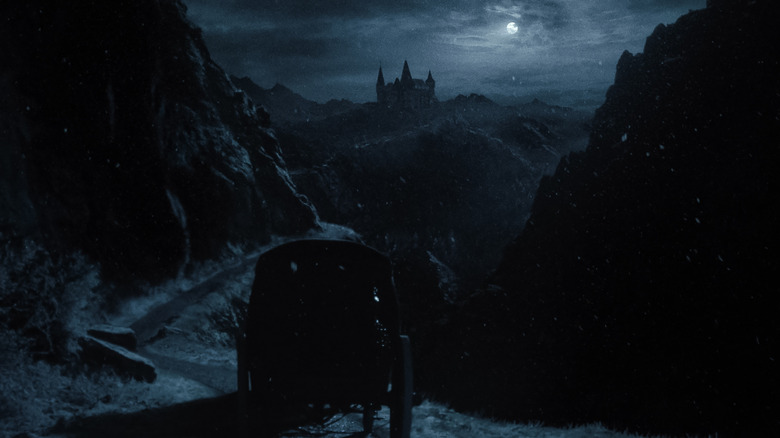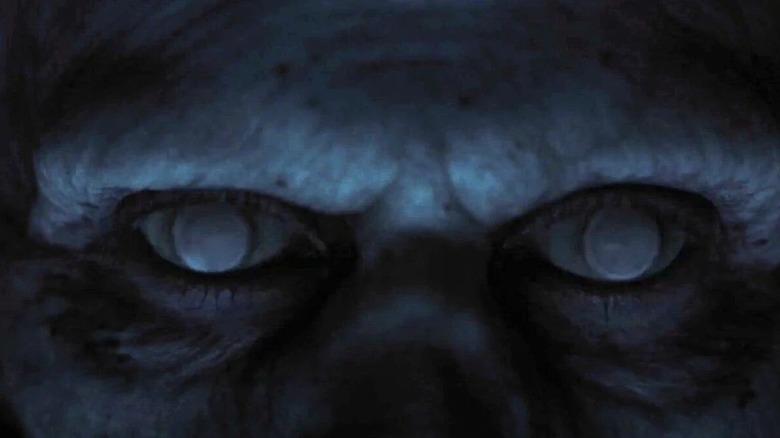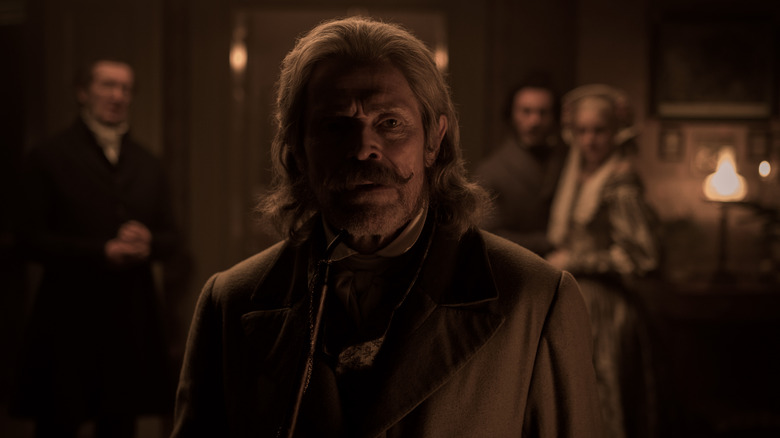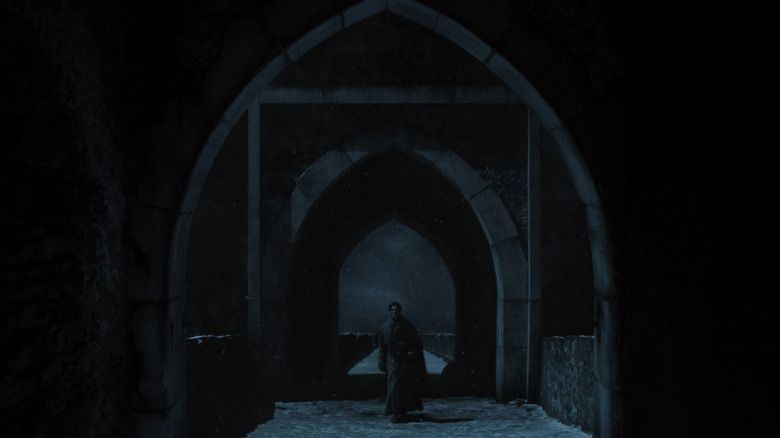
This article contains mild spoilers for “Nosferatu.”
There is much within Robert Eggers’ film “Nosferatu” that is to be expected. If you’re familiar with the prior cinematic incarnations of Dracula, vampire movies in general, Eggers’ filmography, or some combination of all three, then you’re not necessarily going to be surprised by everything in the film. There’s a lot of bloodletting, a palpable sense of dread, an authenticity of time and place, and a psychosexual relationship between the vampire Count Orlok (Bill Skarsgård) and his victims — all aspects that foreknowledge of vampire movies and Eggers’ work should prepare you for.
However, part of the joy that comes with following the work of a true auteur is seeing how much they can still surprise you, even as they remain true to their quirks and proclivities. “Nosferatu” is as undeniably Eggers’ film as it is a quintessential vampire movie, and yet it’s honestly a little shocking just how fresh and vibrant it feels. Yes, part of this is likely due to how inundated we are with vampires in media —even a little zig where we expect a zag is enough to capture some attention — but the gusto with which the filmmaker attacks this material has to be seen to be believed, especially when it comes to how frightening the film is. After all, we’re pretty accustomed to vampires at this point in pop culture, so how could they be this scary again?
The answer, of course, lies in craft and presentation, two things that Robert Eggers excels at. The way he films Skarsgãrd in the movie, along with the other filmmaking techniques and elements he employs, combines to make “Nosferatu” one of the scariest vampire movies ever made.
Skarsgård and Eggers take Orlok into the uncanny valley
By far one of the most surprising, fascinating, and even shocking aspects of “Nosferatu” is the way Skarsgård’s Count Orlok is performed and presented. This is, of course, in keeping with “Nosferatu” tradition, as F.W. Murnau’s original 1922 film (based unofficially on Bram Stoker’s novel “Dracula”) featured actor Max Schreck portraying Orlok in makeup that the actor designed himself which is still remarkably effective and creepy over a century later. Schreck’s presence is further enhanced by the many rumors and unanswered questions about him that persist to this day, urban legends that lead to a fictionalized take in 2000’s “Shadow of the Vampire,” a film that posits the idea that Schreck was a real-life creature of the night whom Murnau hired on the sly.
In a letter written by Eggers to Critics Choice members, the director went into some detail as to how he, Skarsgård, and his collaborators like costume designer Linda Muir and makeup prosthetics designer David White helped make their Orlok just as eerie and uncanny by giving him a “folk vampire look.” As Eggers described:
“Bill Skarsgård’s Count Orlok is the first time that a Dracula character has been presented as a vampire of folklore — a walking corpse, more like a zombie in appearance — as well as the first time that he is attired as a Transylvanian nobleman.”
That aesthetic and its clash of the horrific with the banal is what makes this Orlok so disturbing. He is at once an eternal creature of myth and the supernatural while being of his place and time; a presence that cannot be ignored or easily dismissed. In addition to the makeup (including a big, bushy mustache that only helps to further hide the actor’s boyish looks), Skarsgård reportedly worked with an opera vocal coach to lower his voice a whole octave. This is, for my money, the most transformative performance from a well-known actor since Robert De Niro in “Raging Bull,” and the overall effect it has on the viewer strikes right at the uncanny valley. We know who it is, but we cannot recognize him, and that puts us exactly where the filmmakers want us to be.
Eggers’ camera keeps you stuck in the nightmare
Perhaps Eggers’ most obvious yet still highly effective trick seen in “Nosferatu” is the way he utilizes his camera. Even a first-time, cursory watch of the film allows anyone to pick up on just how long Eggers, cinematographer Jarin Blaschke, and editor Louise Ford hold onto numerous shots. This technique establishes one of the film’s major themes, which is the way Orlok and vampirism have an effect on the human psyche which is dreamlike, blurring the line between dreams and reality. It’s the movie’s most major connection with Wes Craven’s “A Nightmare on Elm Street,” which features similar scenes of characters who appear to be having a dream only for it to be hinted that the events really occurred (or vice versa).
In other words, “Nosferatu” is a waking nightmare, and Eggers wants to keep the audience trapped in this nightmare along with his protagonists. The director states in his aforementioned letter that these “long unbroken tracking shots” required the help of not just the camera department, but also the lighting department (for the candles that light many of the scenes) and the production designer Craig Lathrop, who had to make sure the sets were wild (re: moveable) to accommodate the camera gliding through and around the space. This choice has an additional effect on the nightmarish one, too, as many shots (particularly those involving the journey to Orlok’s castle in Transylvania) fly through the space as if from a first-person point of view. Whose POV this represents is a debatable point, suffice to say that ultimately, it’s the audience’s POV, making the act of watching “Nosferatu” an experiential one. Eggers doesn’t break the fourth wall completely, but there’s no doubt that we’re part of his film, too.
Color without color in ‘Nosferatu’
From a most noticeable technique to a subtle one: “Nosferatu” is a movie shot in color, yet features a distinctly monochromatic palette. Every set that Eggers and Lathrop have designed seems to have been painted and coordinated to subtly suck (pun intended) the color out of everything, even before Count Orlok arrives in Germany. Of course, this is partially because Ellen (Lily-Rose Depp) is our main character, and she’s been stalked, courted, and molested by Orlok for years prior to the story’s beginning. Another reason for the look is that it recalls both the classic Murnau silent film and the 19th century in general, or at least our collective unconsciousness’ version of that period, given our cultural connective shorthand between the past and black and white.
Above those reasons is the fact that this palette enhances the effects of the prior two aspects of the film. It further adds to the uncanny valley of Orlok and the movie itself, playing literal tricks on our eyes as we watch the movie. It also increases the dreamlike nature of the movie, creating a false impression in some viewers that the film actually is shot in black and white, making one’s recollection of its images tainted and that much more untrustworthy. Like the master of horror he is, Eggers cannily combines the more expected trappings of the genre — music stings, jumpscares, aggressive sound design, histrionic performances, and lots of blood — with these subtler, more disturbing elements. The overall effect this has is that when the sting of the films’ expected scary elements has faded, the insidious subtle aspects continue to unsettle.
Finally, the choice to shoot a movie in color with barely any emphasis on color helps with the film’s other hero besides Ellen — the daylight, which is the only thing that can defeat Orlok. Eggers appropriately holds back on sunlit scenes until the very end of the film, with even the candlelight just not enough to fully dispel the darkness. With this and all of its craft on display, “Nosferatu” becomes as rich an experience as one can hope for in a horror movie, one that scares just as well on a first watch as it does on a repeat viewings.





Leave a Reply